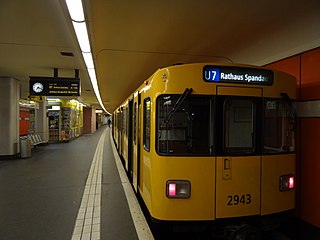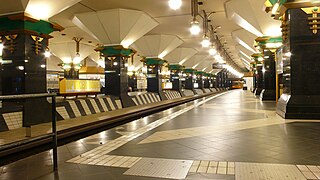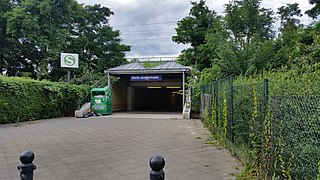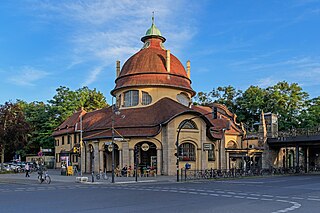
The Berlin U-Bahn is a rapid transit system in Berlin, the capital and largest city of Germany, and a major part of the city's public transport system. Together with the S-Bahn, a network of suburban train lines, and a tram network that operates mostly in the eastern parts of the city, it serves as the main means of transport in the capital.

U2 is a line of the Berlin U-Bahn. The U2 line starts at Pankow S-Bahn station, runs through the eastern city centre (Alexanderplatz) to Potsdamer Platz, the western city centre and finally to the Ruhleben terminal station.

The U7 is a rail line on the Berlin U-Bahn. It runs completely underground for a length of 31.8 kilometres (19.8 mi) through 40 stations and connects Spandau, via Neukölln, to Gropiusstadt and Rudow. The U7 was originally the south-eastern branch of the Nord-Süd-Bahn (U6) that ran between the branching point at Belle-Alliance-Straße (Mehringdamm) and Grenzallee; however, in the 1960s, this stretch was separated from the rest of the line and extended at each end to form a new line.

U9 is a line on the Berlin U-Bahn. The line was opened on 28 August 1961 as Line G.

Rathaus Spandau is the western terminus of Berlin U-Bahn line U7. It was opened on 1 October 1984 with the line's extension from Rohrdamm to Rathaus Spandau. The station takes its name from the nearby Rathaus Spandau, the historic city hall of Spandau.

Berlin Jungfernheide is a railway station located at Charlottenburg-Nord, in the Charlottenburg-Wilmersdorf district of Berlin, served by the S-Bahn lines S41 and S42, the U-Bahn line U7 and Regional-Express trains of the Deutsche Bahn. Its name literally translates into "maidens' heathland"; it was named after the Jungfernheide, a former large forest in the proximity of this station.

Gleisdreieck is an elevated Berlin U-Bahn station located on a viaduct in the Kreuzberg district, and served by lines U1, U2, and U3. The U1/U3 platform is at a higher level than, and perpendicular to, that of the U2.

Wittenbergplatz is a Berlin U-Bahn station on lines U1, U2, and U3. The station is located at the Wittenbergplatz square in Berlin's City West area, in the northwestern corner of the Schöneberg neighbourhood. It is the only U-Bahn station in the city with five adjacent tracks and three platforms. The station building, erected in 1911–1913 according to plans designed by Alfred Grenander, is listed as an architectural monument.

Märkisches Museum is a Berlin U-Bahn station located on the U2 in the Mitte district. Since 1935 it has been named after the nearby Märkisches Museum, the municipal museum of the history of Berlin and the Mark Brandenburg.

Mohrenstraße is a Berlin U-Bahn station on line U2, located in the district of Mitte.

Bismarckstraße is a Berlin U-Bahn station on lines U2 and U7, located in the Charlottenburg district. It was opened in 1978 on the eponymous street, a major arterial road named after Otto von Bismarck.
This is a disambiguation page. Ruhleben may refer to

Berlin Alexanderplatz is a German railway station in the Mitte district of Berlin's city centre. It is one of the busiest transport hubs in the Berlin area. The station takes its name from its location on Alexanderplatz, near the Fernsehturm and the World Clock.

Westend is a locality of the Berlin borough Charlottenburg-Wilmersdorf in Germany. It emerged in the course of Berlin's 2001 administrative reform on the grounds of the former Charlottenburg borough. Originally a mansion colony, it is today a quite densely settled, still affluent territory adjacent to Berlin's inner city in the east.

Berlin-Spandau station is a Deutsche Bahn station in the Berlin district of Spandau on the south-western edge of the old town of Spandau. The railway junction station is one of the 80 stations classified by Deutsche Bahn as a category 2 station. It has the longest train shed in Germany.

Berlin Mexikoplatz is a railway station in the Zehlendorf district of Berlin, Germany. It is served by the Berlin S-Bahn line S1 and several local bus lines. It is also planned to extend the U3 U-Bahn line here.

The U12 is an inactive Berlin U-Bahn line. It existed between 1993 and June 2003, as a peak-time and night line between Ruhleben and Warschauer Straße stations. The route remains available for temporary use when it is not possible to run a full U1 or U2 service for reasons such as maintenance.

Bus transport is the oldest public transport service in Berlin, the capital city of Germany, having been introduced in 1846. Since 1929, services have been operated by the Berlin Transport Company, although during the Cold War-era division of the city they operated in West Berlin only. In East Berlin the public transport agency split off from the BVG and rebranded as BVB, operating the busses in the soviet sector of Berlin.

The Berlin–Lehrte railway, known in German as the Lehrter Bahn, is an east–west line running from Berlin via Lehrte to Hanover. Its period as a separate railway extended from its opening in 1871 to the nationalisation of its owner, the Magdeburg-Halberstadt Railway Company on 1 July 1886. The company's Berlin station, the Lehrter Bahnhof was finally torn down in 1958.
The tracks of the Berlin subway are lines operated in the line traffic, operating distances, which serve only internal purposes, turn-off and turning plants and plants in the operating farms.






















